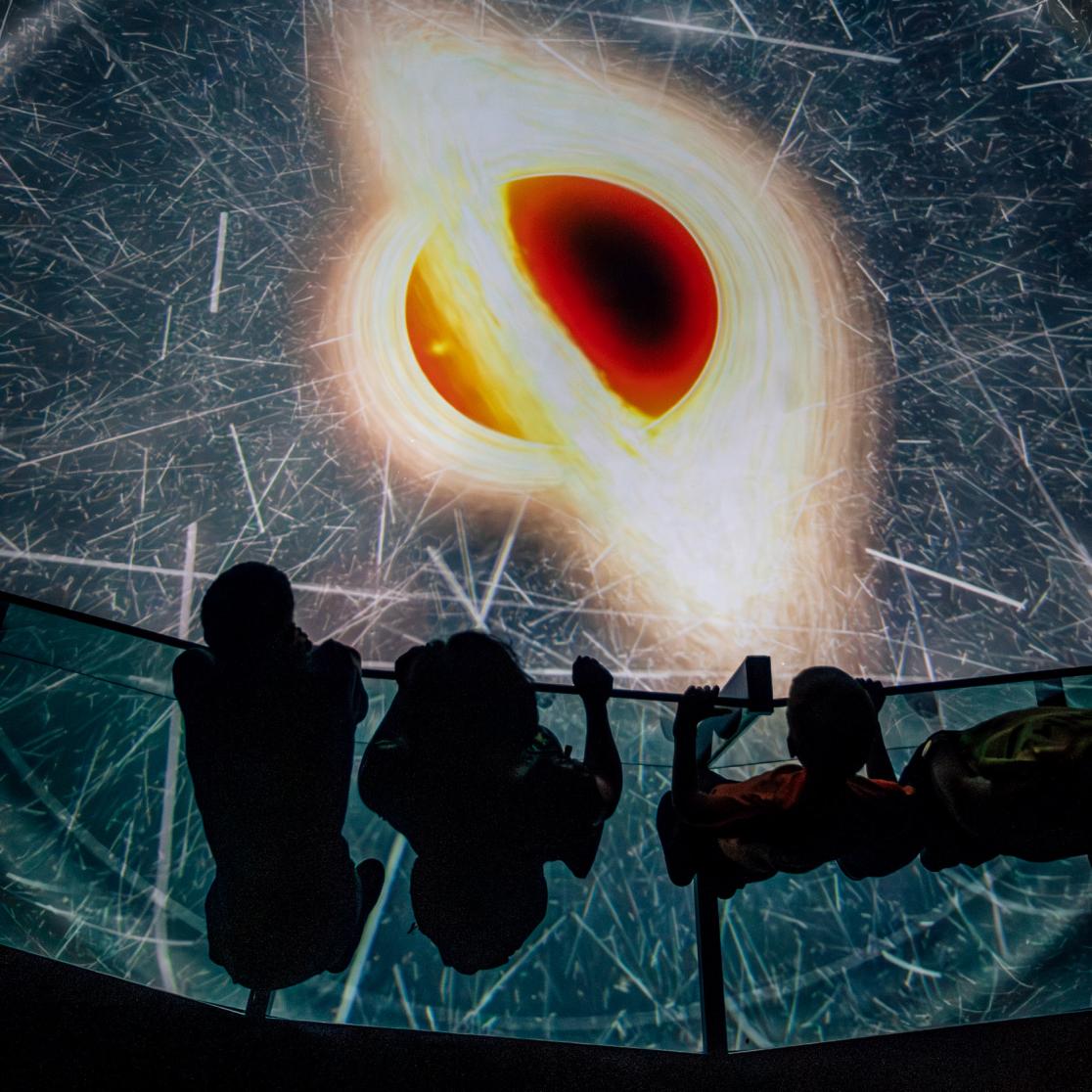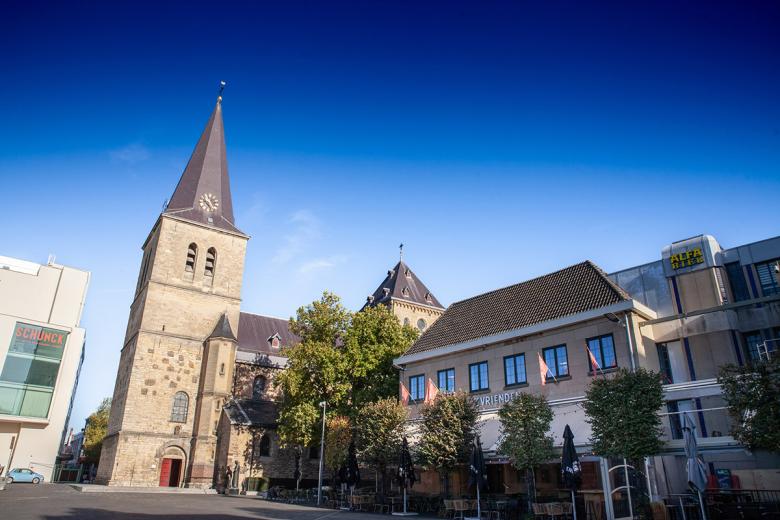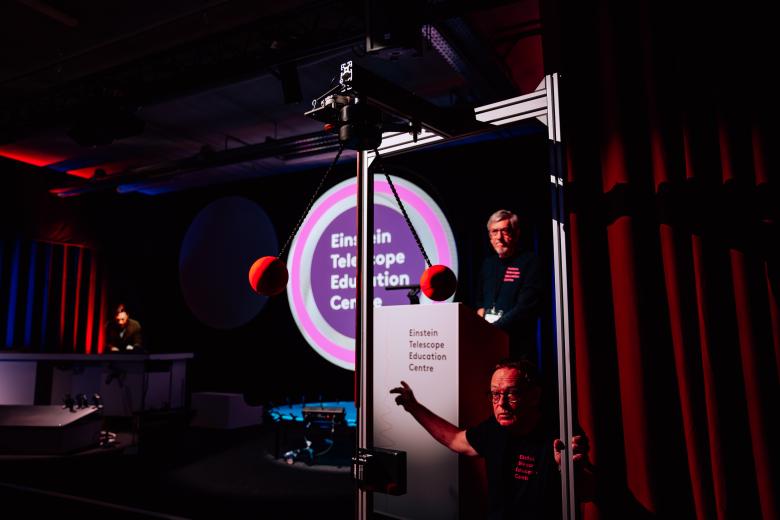In Kerkrade, you can listen to the invisible universe
Thanks to the Einstein Telescope, we will soon be closer to unravelling the mysteries of the universe. Maastricht University and Discovery Museum in Kerkrade join forces to make this understandable for everyone. At the Einstein Telescope Education Centre (ETEC), you discover what makes this ‘telescope’ so special.
The lights go out, and the floor disappears beneath your feet. Below you, you see billions of lights flickering in the darkness: the stars in our Milky Way. A visit to the Einstein Telescope Education Centre (ETEC) in Discovery Museum begins with the film Spacetime. You don't watch it on a screen, you view it in a special auditorium with a large gap in the floor. The film is projected into it, raising questions about black holes, gravitational waves and the universe. Questions that ETEC answers.
Invisible signals
There is a good reason you’re looking down: the Einstein Telescope is an underground observatory. It will be located at a depth of 250 to 300 metres – perhaps here in the south of Limburg. We call it a telescope, but it is actually a gravitational wave detector. “Gravitational waves are invisible signals from space,” says Emma Prins, PhD candidate and researcher who co-developed the ETEC programme. “Highly sensitive equipment, such as the Einstein Telescope, can make these waves visible.”
Dark side of the universe
From underground, the Einstein Telescope measures gravitational waves from space. This is important because these waves tell us something about a largely unknown part of the universe. “With optical telescopes, we can only see five per cent of the universe,” says Prins. "With special detectors, we listen, as it were, to the dark side of the cosmos. There are already a few of these detectors on Earth, including in the United States and Italy, but they are not nearly as sensitive as the Einstein Telescope will be."
What will researchers be able to ‘hear’ soon? Prins explains: "We can already measure very large waves, for example, when black holes or neutron stars collide. But actually, gravitational waves are constantly passing by the Earth. All mass moving through the universe causes gravitational waves, but most are too small for us to measure. The Einstein Telescope will enable us to learn more about these. Ultimately, it will allow us to map the entire history of the universe – and with it, the future."
(Text continues below the photo gallery)
Gideon Koekoek is associate professor of physics at the Gravitational Waves and Fundamental Physics (GFWP) research group. Koekoek combines teaching theoretical physics with research into gravitational waves and general relativity. He also coordinates various outreach projects related to the Einstein Telescope.
Emma Prins is PhD candidate at Nikhef (National Institute for Subatomic Physics) and Maastricht University. Prins' research focuses on vibration-free cooling of the Einstein Telescope. In addition, she conducts research into the effectiveness of educational initiatives related to gravitational waves, such as ETEC, on both students and teachers.
Watch a een photo impression of the Gravity Tour in the Einstein Telescope Education Centre (ETEC).
Photos: Discovery Museum, Paul Rous.
Click on the icon to browse through the photos
Experience it for yourself
Every first Sunday of the month, you can take part in the Gravity Tour at ETEC. This is a guided tour for the general public, during which you can view Spacetime, attend an interactive lecture and learn all about gravitational waves and the technology behind the Einstein Telescope.
ETEC focuses in particular on secondary school pupils. Pupils in years 4, 5 and 6 of can participate in ETEC's day programme with their teacher. They discover how this complex subject ties in with what they already know from their physics lessons. They soon realise that they understand quite a bit.
School classes receive a more extensive programme than participants in the Gravity Tour. For example, pupils take part in workshops where they operate a laser themselves, learn how to reduce vibrations and analyse real gravitational waves that come in via existing detectors. They then dive into the studio and create a production about what they have learned, ranging from a podcast or news item to a craft project.
Want to learn more? (Information in Dutch)
Test facility unique to UM
ETEC develops the programme content in collaboration with Maastricht University. UM is closely involved in the Einstein Telescope project. For example, the ETPathfinder, a test setup for the Einstein Telescope, is located in the DUB30 university building. The ETPathfinder is part of UM's research centre The Department of Gravitational Wave Research and Fundamental Physics (GWFP).
Gideon Koekoek is involved in GWFP as an associate professor of physics. Koekoek was scientific leader in the design of ETEC and is now conducting research with Prins into the effectiveness of educational initiatives relating to gravitational waves. "It’s not yet certain whether the Einstein Telescope will be built here in the south of Limburg in 2027," says Koekoek. “But our research in Maastricht will continue regardless. The ETPathfinder will remain the test facility for the detector. The Einstein Telescope is a European consortium involving several countries. Within that consortium, there is an agreement that the test facility is located uniquely here and that we’ll share the data it produces with the other countries. And that will certainly be the case for the next fifty years.”
Text: Caya Forman
Photo's: Discovery Museum

Also read
-
Municipality of Heerlen, Parkstad Urban Region and UM invest 6 million in collaboration
Heerlen grants a one-time contribution of €1,478,050 to Maastricht University as part of the Regio Deal application ‘Fundament onder UM-onderwijs in Heerlen’ . This amount comes from the Fonds Economische Structuurversterking (FES) . The funding will help establish university education facilities in...
-
Special Collection Policy Briefs handed over to Marieke Spijkerboer, Director Sustainable Living Environment and Circular Economy
AMIBM researchers Marco Serafini, Cris Garcia-Saravia Ortiz-de-Montellano, and Yvonne van der Meer contributed to a unique collection of policy briefs published by Studio Europa Maastricht. The document investigates the goals of establishing a European circular economy and considers its policy...
-




